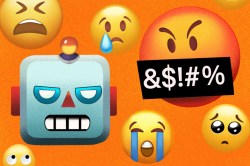Account profiling
So why do companies even need to gather data on the preferences of certain users? The answer depends on the company’s intentions. For example, they could seek to improve their product by finding out the individual tastes and qualities of certain groups of customers. For this purpose they would need not only to find out their psychological types, but also monitor their feedback in social media. If a customer makes a negative review of a product, the algorithm needs to be able to determine their individual characteristics and to offer the company some ways of dealing with the negative feedback and regaining the customers’ loyalty: perhaps they should be offered a discount or motivated to try a different product?
“We worked, among other things, on compiling guidelines for working with various client groups. For instance: how to best deal with women unsatisfied with product design or with men who find the prices unreasonable. Meaning that the project doesn’t focus on individual treatment of particular customers, but on working with attributes that determine customers’ behavior types,” – comments Kseniya Buraya, a research associate at the International Laboratory “Computer Technologies” and one of the students who participated in the internship program in Singapore.
This method of profiling, e.g. identification of customers’ behavior and preferences, can be applied to a large variety of situations. Oftentimes a certain product fails to satisfy its customers and the discussion on social media starts to grow like an avalanche. It’s important for a company to take notice of when the first signs of discontent appear and answer the complaints in a proper manner, adds another participant, Master’s student Denis Mekhanikov. Account analysis can also help gather statistics on the online activity of one’s competitors. The technology might be useful to “headhunters”, intelligence operatives and other people whose line of work involves figuring out someone’s personality and behavior patterns.

Credit: g1.dcdn.lt
Profiling algorithm
The algorithm works with sets of data that social network users voluntarily post on the internet, such as geotags, public posts, personal bios, photos and captions. All this information is translated into parameter sets that are then processed using machine learning models. For the algorithm to learn how to identify the unique qualities of users, researchers “train” it using an existing set of data, meaning that the result of their analysis is already known. The software needs to build connections between the parameters to come to the same conclusions. Basically, the neural network is trained to match the data with what it means. After training, the software will be able to produce accurate results by itself.
The same method can be used to analyze not just text, but, for example, users’ Instagram photos. By comparing the data about someone using their profiles from various social networks, the algorithm can provide its programmers with a more complete picture of the customer’s tastes. Earlier on, Ms. Buraya and other Master’s students have taught the algorithm to determine a user’s marital status based on their social media accounts.
“How does this apply to business? Suppose a company has an official Twitter account with a number of followers. We can gather information on these users and, having analyzed it, provide some guidelines on how the company needs to handle the various groups of its clients in a critical situation. Of course, for the algorithm to work the company’s brand name needs to be mentioned in posts or photo captions,” – explains Master’s student Ivan Samborskii.
It should be noted that social networks don’t always properly reflect someone’s personality. For instance, earlier on the team analyzed the Twitter account of the US President Donald Trump, which resulted in the algorithm declaring Mr. Trump a bachelor (which he isn’t). The mishap could have occurred due to the fact that the politician’s account is maintained not only by him, but by a number of assistants.

Donald Trump's Twitter account. Credit: twitter.com/realdonaldtrump
“This kind of analysis can help companies understand if their customers would be in favor of a particular new product. For example, the company may “plant” a new concept on social media. This can be done in several ways: an official announcement on new developments, products, features or even a pretend “leak”. Users will inevitably react to such information and their reactions can be gauged to determine their opinions on the possible new product,” – says Ms. Buraya.
Working in Singapore
According to the participants of the internship at the National University of Singapore (NUS), the government of the city-state is doing its best to turn as many innovative ideas as possible into startups. To this end, they provide grants and scholarships; the project on which ITMO University’s Master’s students were working on was no exception and was developed using grant funding. However, work on projects like this can only be conducted in Singapore – such are the strict rules set by the government.
“Seeing as it is a city-state, a lot of research there focuses on innovations in urban environment and modern technologies. There is a lot of development in the field of self-driving cars. NUS has its own medical clinic where they develop treatment methods for cancer and the Zika virus – almost a third of the university belongs to the medical cluster,” – notes Mr. Samborskii.
He adds that each of the university’s professors have their own laboratory where they work with their research teams. There is also a building reserved for project work. That is where the larger laboratories are located and where scientists test robots, drones and various other developments. The researchers often meet with investors and entrepreneurs during special events. Once a week ITMO University’s Master’s students met with their project’s business-mentor who helped them participate in workshops, create presentations for their project, and advised them on how to promote their product.
“You tell investors about your project and they’re ready to put it to use, well, figuratively speaking, tomorrow. Because of that, innovations develop quite fast over there” – says Kseniya Buraya.

Singapore skyline. Credit: tcc.com.ua
Living in Singapore
Despite the fact that Singapore is considered to be one of the world’s most cosmopolitan cities, it still takes some time to get used to living in the city-state, say the students. Here are a few things to keep in mind about Singapore:
№1: difficulties in finding lodging. Very few landlords are willing to rent out apartments for less than six months and rent will no doubt take up most of one’s expenses.
№2: the language barrier. Despite the fact that most citizens speak English, the varying Singaporean accents can be quite difficult to understand. However, most of the younger students at the university campus lack the accent and are much easier to communicate with.
№3: the hot, humid climate. The students compare being outside to sitting in a Russian banya. Heavy rains are common. Still, there are canopies everywhere under which one can escape from sun and rain, while buildings and public transit are equipped with air conditioning.
№4: the lacking entertainment industry. The Singaporeans’ main leisure activities are food and shopping. Although the city does have a lot of bright and spacious parks and many sports facilities.
№5: Singaporeans are always hard at work. This isn’t an upside or a downside, but rather a lifestyle that one needs to be familiar with. The students say they were working almost all the time, while some of their Asian colleagues even kept folding beds in their laboratories to save time.
“Life and work in Singapore is an experience after which you are prepared for anything. It’s a completely different culture, different people and different habits, a radically foreign environment compared to ours. Yet it is in a foreign country where it is easiest to dedicate all of your time to research and submerge yourself in work. This is facilitated by both the local psyche and the fact that you don’t really have anything else to do there. Sure, we’d get out on the weekends and met new people, but still, we had a lot of opportunities to develop our research” – says Ms. Buraya.
Almost all of the Master’s students who took part in the internship at NUS will return there to continue their research or work on their theses.





